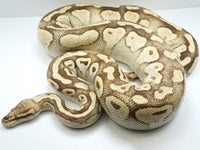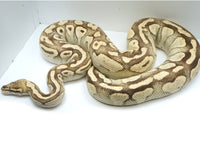Ball Python FAQs - How To Take Care Of A Ball Python

Ball Python FAQs and Care Information
Common Name: Ball Python
Scientific Name: Python Regius
Family: Pythonidae
AKA: “Royal Python”
General Ball Python Information:
Distribution:
Central and West Africa.
Ball Pythons - Wild Status:
Large populations exist but are being reduced due to excessive habitat destruction, skin trade and the pet trade. In some collected areas the populations remain stable due to agricultural activities and the created artificial rat populations. In Ghana, Africa the ball python trade is regulated by the government and attention is put into keeping a viable population of adults in the wild to create the next generations for future collection. Gravid females are collected and then returned to the wild by government officials; a percentage of the babies hatched are also being released back into the wild.
Treating these animals as a sustainable resource has possibly increased the local population range and may help to secure the future of these animals in the wild. In other countries, however, ball pythons are collected with absolute disregard for the “overall picture” and impact on wild populations and are sold as meat or living animals. Adults are now being exported in huge numbers to the Asian markets where they are being used for their meat and blood, Recently there has been interest in butchering & canning the ball pythons in Africa for export as a meat product for the Asian markets. This single activity could bring the demise of large populations, as they cannot sustain such losses without wiping out entire areas. Until the government takes notice Benin and Togo are draining themselves dry of their ball python populations.
Description:
Ball pythons are robust serpents with a distinctive head & slender neck. Normal body coloration is black with yellow, gold, or brown markings. Pattern may be “broken,” banded or reduced in some specimens, and many exhibit varying degrees of broken dorsal striping.
Wild-caught ball pythons are notorious for being difficult to acclimate: these are the animals that give balls their reputation for being terrible feeders. Going with a captive born, well established ball python is a must for making your first ball python experience a good one. These are somewhat shy snakes that fare much better in captivity when acquired from a reliable CB source.
Ball Python Size:
Hatchlings: approximately 10″+/-.Adult size: Females average 3′- 5′. Males average 2′ – 3′.
This is a species in which mature females are typically distinctly larger than the males. A 5+ foot ball python is considered large, although lengths of 6+ feet have been reported.
Lifespan: 15 Years
Ball pythons may live 40 years or more if kept properly in captivity.Ball Python Color Mutations:
There are over 6.000 genetic combinations that have been created thus far throughout ball pythons with new combinations being produced every year from breeders throughout the US and worldwide!Captive Ball Python Maintenance Guidelines:
Ball Python Keeper Difficulty Level:
Beginner. Easy, but keeper must have a general knowledge of snake husbandry. Captive bred, well started ball pythons make an excellent first snake for the beginning herpetoculturist.
Proper Enclosures For Ball Pythons:
Enclosures can be as simple or elaborate as one is capable of caring for. Remember that the more “stuff” you put in a cage, the more “stuff” you have to clean & disinfect on a regular basis. That said, there are many different enclosures that work extremely well for ball pythons, including, but not limited to: plastic sweater boxes (i.e. Rubbermaid), melamine racks, Freedom Breeder cages, and any of the commercially available plastic-type reptile cages, (i.e. those from Vision Herp & other similar manufacturers).
Glass aquariums & tanks are adequate; keep in mind that the screen tops on such enclosures can make it very difficult to maintain humidity levels. Also refer to our Snake Caging care sheet for more information. Juvenile ball pythons seem to do well in smaller enclosures that make them feel more secure; a small snake in a big cage can become overwhelmed & stressed.
Fortunately adult ball pythons do not require exceptionally large or elaborate enclosures. A 36″ x 18″ x 12″ enclosure will more than comfortably house an adult ball python. Remember that ALL enclosures must allow for a proper thermal gradient that the snake can utilize, with a hot spot on one end and a cooler spot on the other.
Best Ball Python Substrate:
There are a few substrates that work well. Newspaper is the cheapest & easiest with regards to cleaning & disinfecting: out with the old, in with the new. Cypress mulch is great for controlling humidity but remember that too much humidity can be as detrimental (if not more) as too little. Never use any substrate containing cedar, as this is deadly to reptiles!
Temperatures & Heating For Ball Pythons:
Provide your ball python with a basking spot of 88-92 °F and an ambient (background) temperature of 78-80 °F. The ambient temperature should not fall below 75 °F. It is vitally important to KNOW the temperatures at which you are keeping your snake(s). DO NOT GUESS!! A great way to monitor temps is to use a digital indoor/outdoor thermometer with a probe. Stick the thermometer to the inside of the cage on the cool end and place the probe on the warm end, and you’ll have both sides covered at once.
There are several ways to go about heating the enclosure: undercage heating pads, ceramic heat emitters, basking bulbs (both regular daytime & red “night” bulbs) are just a few. With heat emitters & bulbs it is necessary to really keep an eye on the humidity within the enclosure, especially if combined with a screen top, as both will dry the air quickly. Use thermostats, rheostats and/or timers to control your heat source. Do not use hot rocks with snakes as they often heat unevenly over too small of a surface area & can cause serious burns.
Humidity:
Providing proper humidity for ball pythons is important, but as stated previously too much humidity can be as problematic as too little. First off, let’s establish “humidity” as the amount of moisture in the air. To provide your snake with a humidity level of 50% – 60%, you have a couple of options.
- Use cypress mulch or a similar substrate that can be misted & is mold-resistant. Cypress is good for this as it turns a tan color when dry & a rich brown when wet, giving a visual cue as to when it needs to be dampened again.
- Make a “humidity box” for your snake. This consists of packing a plastic container with damp sphagnum moss (think well-wrung-out wash cloth to gauge moisture), cutting a hole in the top or side & placing it in your python’s enclosure so that it can access the box as it pleases.
One of the biggest problems we observe in captive ball pythons is respiratory distress caused by the combination of low ambient humidity, improper ambient temperatures, and a screen-top enclosure which basically allows the environment within the snake’s cage to be affected by any external influences in the room in which the snake is kept. Keep in mind that if you have a screen top on the enclosure you will probably want to cover it most or all of the way with plastic, a towel or some other means of keeping moisture from escaping. This is also where having proper, reliable ambient temperatures (back to that thermometer!) is important, as warm air holds more moisture than cool air. You want the enclosure to be humid, not WET. A soggy cage can eventually lead to bacterial & fungal infections and consequently, death.
Lighting:
Supplemental lighting is not necessary for this species, but if used should run on a 12/12 cycle, meaning 12 hours on & 12 hours off. Continuous bright, overhead lighting is stressful to snakes, especially a nocturnal serpent such as this one.
Hydration:
Always make fresh, clean water available to your ball python. The size of the water dish is up to you. If it is large enough for the python to crawl into and soak, sooner or later your snake will make the most of the opportunity, and most seem to enjoy a nice soak from time to time. Ensure that the bowl is not too deep for juvenile animals – 1″ or so will suffice. Snakes of many species will defecate in their water bowls from time to time, so be prepared for cleaning, disinfecting & a water change when necessary. It is often beneficial to have a spare water bowl for such occasions, so that one may be used while the other is being cleaned.
Caging Accessories:
The one cage accessory that is beneficial to a happy ball python is a good hide box…maybe even a couple of them. These are secretive snakes that appreciate & utilize a hide spot. Provide one on each end of your python’s enclosure so that it does not have to choose between temperature & security. Clay flowerpots, plastic flowerpot trays, and commercially available hide boxes all work quite well.
Feeding A Ball Python:
Feed your ball python an appropriately sized rodent weekly. By “appropriately sized” we mean prey items that are no bigger around than the python at its largest point.
Ball pythons can eat rats from the time they are young – starting off with rat pups or “crawlers” for younger snakes & moving up in size as the animal grows. Do not handle your snake for at least a day after feeding, as this can lead to regurgitation. Ball pythons can be converted to feeding on frozen/thawed or pre-killed rodents. Never leave a live rodent unattended with ANY snake. Ball pythons are well-known for going on hunger strikes at certain times throughout the year, particularly in the winter months.
Be prepared for the possibility of your snake going off feed and keep an observant eye on the snake’s overall condition and body weight. This is typically nothing to worry about with healthy, well established pythons, although it can be extremely frustrating to the keeper. If your snake is healthy continue your husbandry routine as usual, yet reduce the amount of handling the snake receives to a minimum.
Offer your ball python food every 10-14 days until interested in eating again, as the snake will eventually “turn back on” and resume feeding normally. You should start to issue concern if your animal is losing weight rapidly or is consistently regurgitating meals. Weight loss and regurgitation can be caused by numerous factors so make sure to check meal sizing and your animal’s enclosure and environment thoroughly!
Cage Maintenance:
Spot-clean your snake’s enclosure as necessary. When feces/urates/uneaten prey items are present, remove them as soon as possible. Clean & disinfect the water bowl on a weekly basis or every time you go to refill water. Depending on cage conditions, remove all substrate & cage furniture and completely disinfect using a 5% bleach solution weekly. Rinse the enclosure thoroughly and allow to dry before replacing cage furniture & your snake. A weekly cleaning of enclosures will deter bacteria build up and allow the animal to remain in a clean environment which greatly reduces the risk of the animal getting ill.











